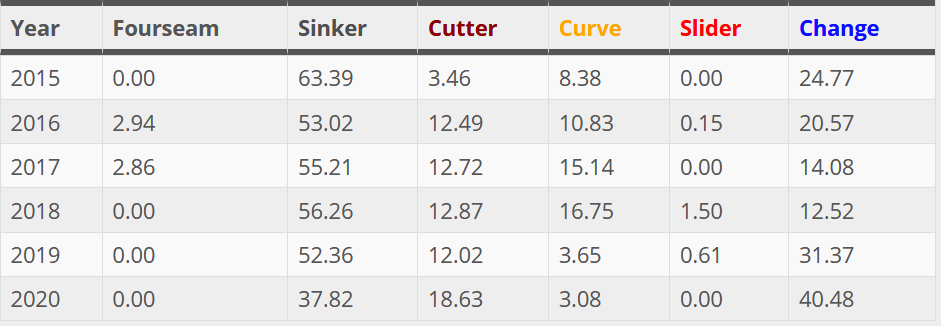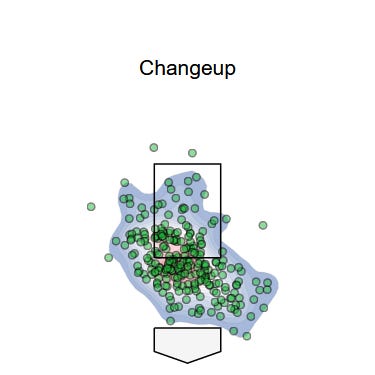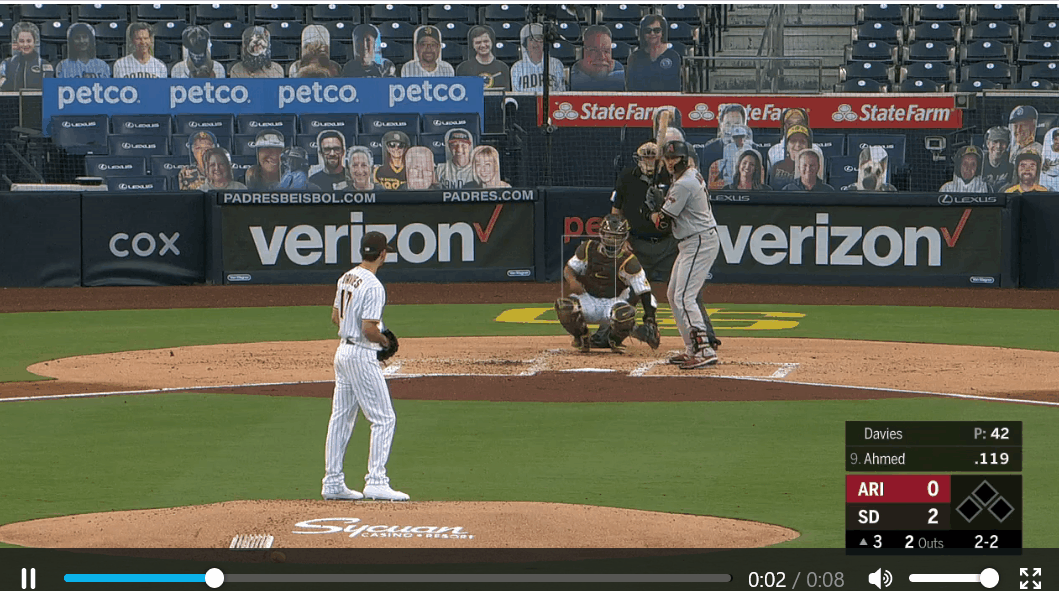In baseball, if you’re going to make a comparison between two players, you usually start with the same handedness. Jacob deGrom isn’t the next Sandy Koufax, he’s the next Tom Seaver or Pedro Martínez. Clayton Kershaw, a southpaw, gets the Koufax comp (postseason results may vary). And Fernando Tatis Jr.’s swing doesn’t remind you of Ken Griffey Jr.’s—okay, maybe if you reverse the image it does—it reminds you of, I don’t know, Manny Ramirez’s.
I’m going to break that convention: Zach Davies is Dallas Keuchel; Dallas Keuchel is Zach Davies. I’ve pondered whether it’s possible that they’re actually the same person, secretly shuttling between teams with a large beard and an ambidextrous pitching style as cover. It’d be an elaborate scheme, sure, but the player—let’s call him Dallas Davies—would make a bunch more money.
Alright, maybe that’s extreme. Here’s what makes them so similar, though.
They’re soft tossers
In seven innings of shutout ball against the A’s last night, Davies threw 105 pitches. Just two of them cracked 90 mph. On the other side, Jesús Luzardo’s first pitch of the night registered at a cool 97.3 mph. According to Brooks Baseball, Davies has never averaged higher than 90.4 with the fastball, and that number has settled in at 88.8 over the past two seasons.
Keuchel is the same guy. I’m telling you. In 2015, he averaged a career-high 90.5 mph with the sinker. Last year: 88.4. This year: 87.6.
Don’t let Keuchel’s velocity fool you, though. He was a Cy Young award winner with the Astros, back in ‘15, and ignoring two ugly seasons at the end of Houston’s arduous rebuild, he’s posted a 123 ERA+ since 2014. Over the offseason, the left hander signed with the White Sox for three year and $55.5 million, and he’s anchored the staff of the upstart South Siders in 2020.
They have similar repertoires
Allow me to present further evident to support my theory.
Davies first (from Brooks Baseball):

And here’s Keuchel:

They both feature sinkers as their main fastball, but both guys have thrown that pitch at a career-low rate in 2020. Plus, they’ve also thrown the cutter and changeup at career-high rates this season while largely dropping their breaking pitches. Hmm…
They have great command
They both have a 7.0 percent walk rate!
Okay, let’s get serious for a second here. Even if we ignore the identical walk rate, they’re both known as excellent command pitchers, which isn’t surprising given the velocity range they work in.
In the offseason, Eno Sarris released a list of the top 10 starters from 2019 in Command+, a metric from Stats Perform. Davies ranked fifth and Keuchel eighth. Then, late last month, Sarris released the same leaderboard for 2020, and Davies had jumped to no. 1. Keuchel’s command has apparently slipped some this season, but Davies and Keuchel have joined another exclusive group as two of just eight pitchers to post a 110 or better number this season in both Command+ and QOS+, the latter of which attempts to measure the quality of a hurler’s stuff. The other six pitchers are deGrom, Aaron Nola, Zack Wheeler, Zac Gallen, Kyle Freeland, and Zack Greinke. It’s a fun list and further solidifies the Davies-Keuchel comp.
They pitch the same exact way
Okay, this might be the most convincing part of the comparison, the one that makes me believe Davies and Keuchel are roughly the two most similar players in baseball. Not only do they have similar velocity, a similar pitch mix and pitch quality, similar command, and even relatively similar results, they also have the same pitching style.
And by that I mean that they use their command to do the opposite of what you might expect: they use it to throw a lot of pitches outside the strike zone. Here’s the bottom five in Zone Percentage—simply the percentage of pitches inside the strike zone—among starters since the start of last season:

There’s Keuchel with the lowest Zone% among the 129 starters to qualify, and there’s Davies just ahead of him. The only pitcher to wedge between Keuchel and Davies is Kyle Gibson, who does not necessarily satisfy this pitcher archetype in other ways. It is interesting that Davies is in the realm of the crafty lefty here, not only near Keuchel but also Jason Vargas, Patrick Corbin, and Wade Miley (he’s no. 124). Corbin, like Keuchel, is the comp you want, but even Vargas and Miley have carved out productive and semi-long careers.
There are, of course, different ways for plus command pitchers to work. Chris Paddack and Wheeler throw pitches in the zone at roughly a 46 percent clip, for instance, which is toward the top of the league. But pitchers with mid-90s (and up) fastballs have a bigger margin for error and can thus pound the strike zone more—though Paddack has occasionally caught too much plate when up in the count. With Keuchel and Davies, precision is more important, and the strike zone is sometimes the enemy.
Here are the changeups each pitcher has throw in 2020, per Baseball Savant. Davies:

And Keuchel:

There’s at least one difference. Keuchel’s changeups cluster toward the low and away corner (to right-handed hitters) whereas Davies’s gravitate more toward the center of the plate and away (to lefties), a result partly related to their opposite handedness. But look how many of the pitches are out of the strike zone, period. The goal for Keuchel and Davies is to aim for the very edge of the zone and then expand, inch by inch, until they have batters chasing their pitches, the ones they can’t do damage with but also can’t risk leaving in the umpire’s hands. Here’s one from Davies

And Keuchel:

Same guy? Pretty close.
You can dig deeper, too, and find more similarities. Their entire plate discipline profiles are similar: batters swing at roughly the same amount of in and out-of-zone pitches and make a similar amount of contact on each type. On First Strike Percentage (it’s just what it sounds like), Davies’s 53.4 percent is last in baseball among the group of starters referenced above. Keuchel? You guessed it—this time he’s third from the bottom. So they’ve got great command and don’t walk many hitters, but both pitchers rarely throws strikes or get ahead on pitch no. 1 of an at-bat. Hey, it works.
The good news for Davies is that if he’s in the same bucket with soft-tossing command guys, like Keuchel, Greinke, and Corbin, he might age well. Corbin’s fallen off a touch this year, but he had career years at age 28 and 29; Greinke once had velocity but lost it, yet he’s about as good now (sitting 87) as he was then (sitting 94), just 10 years older; and Keuchel won a Cy Young at 27 but has pitched to a 114 ERA+ since then and currently ranks second in the American League in ERA. Once a pitcher shows he can succeed at a lower velocity threshold, there’s simply less that can go wrong. A dip in velocity might be less likely, for one, since there’s not as much room to go down. And good health might be better kept. And beyond that, the command generally sticks, so the profile has some staying power.
Davies is under team control for another season, but at some point the Padres could consider extending him. They’re loaded with starters, especially after adding Mike Clevinger at the trade deadline, but Davies has been as reliable as they come, plus he gives a rotation of flamethrowers a different look. He also might start thinking he’s Keuchel himself and want a similar contract, which wouldn’t be out of play if he keeps pitching like a quasi-ace.
Either way, Davies’s similarities to Keuchel should bode well for his future. Even if they’re not the same person—I’m still not convinced—they’re both succeeding against the grain, with low-speed heaters but complete control of their domain.



Great to have the newsletter back!